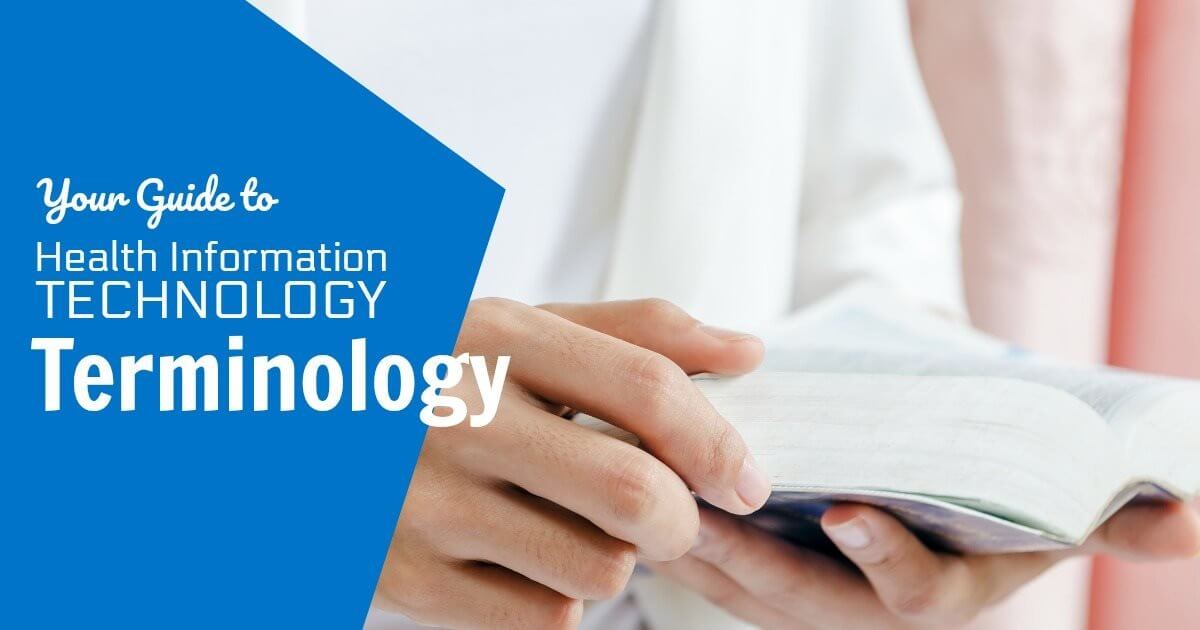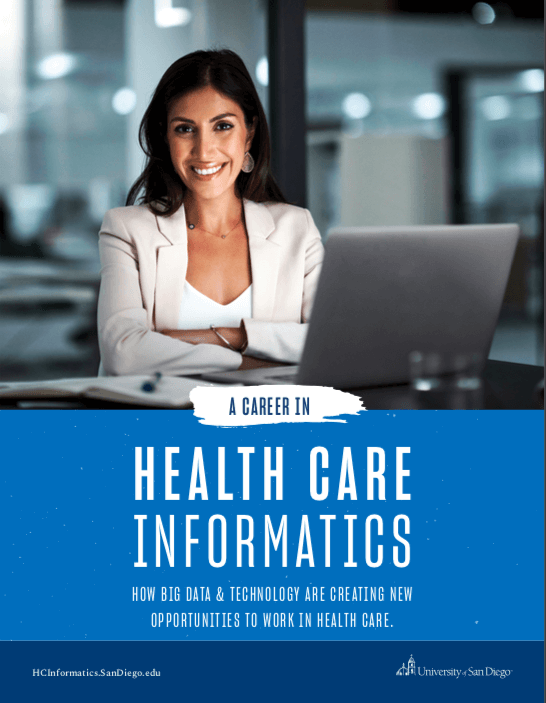It’s no secret that health information technology is revolutionizing the world of health care — producing dramatic changes both in the ways that physicians and institutions practice health care and in the ways that patients (now increasingly regarded as “consumers”) experience it.
Meanwhile, health information technology terminology — the vocabulary we use to define, describe and communicate about these changes — is also evolving at a rapid pace. From EHRs and HIPAA to the rise of health informatics, the conversation about health care today includes important new health information technology terms (and acronyms!), some of which did not even exist as recently as a decade ago.
This glossary covers some of the key terms that you’ll want to be familiar with — whether you are a health care consumer or someone who is interested in pursuing some of the new health informatics career opportunities.
Health Information Technology Terminology
AHIMA
Founded in 1928 to improve the quality of health records, the American Health Information Management Association describes itself as “the premier association of health information management (HIM) professionals worldwide,” serving 52 affiliated state associations and more than 103,000 health information professionals. It strives to play a leadership role in the effective management of health data and medical records needed to deliver quality healthcare to the public and is a respected authority for rigorous professional education and training.
AMIA
The American Medical Informatics Association is a professional scientific association focused on “transforming health care through trusted science, education and the practice of informatics.” Connecting a broad community of professionals and students interested in informatics, it strives to be a resource for informaticians and — through education, training, accreditation, and certification — to support the current and next generation of informatics professionals.
ANIA
The mission of the American Nursing Informatics Association is “to advance nursing informatics through education, research and practice in all roles and settings.” Founded in 1992, it describes nursing informatics as a specialty that “integrates nursing science, computer science and information science to manage and communicate data, information, knowledge, and wisdom in nursing and informatics practice.”
Biomedical Informatics
AMIA defines biomedical informatics as “the interdisciplinary field that studies and pursues the effective uses of biomedical data, information, and knowledge for scientific inquiry, problem-solving and decision making, motivated by efforts to improve human health.”
Centers for Disease Control and Prevention (CDC)
This federal agency is dedicated to protecting health and promoting quality of life through the prevention and control of disease, injury, and disability. Committed to programs that reduce the health and economic consequences of the leading causes of death and disability, thereby ensuring a long, productive and healthy life for all people.
Centers for Medicare and Medicaid Services (CMS)
The federal Department of Health and Human Services (HHS) agency responsible for Medicare and parts of Medicaid. CMS is also responsible for certain aspects of the Health Insurance Portability & Accountability Act (HIPAA).
Certified Health Data Analyst (CHDA)
The AHIMA credential awarded to individuals who have demonstrated skills and expertise in health data analysis.
Certified in Healthcare Privacy and Security (CHPS)
The AHIMA credential that recognizes advanced competency in designing, implementing and administering comprehensive privacy and security protection programs in all types of healthcare organizations. Requires successful completion of the CHPS exam.
Chief Medical Information/Informatics Officer (CMIO)
In hospitals or health systems, a physician charged with helping to assure the success of clinical information systems, representing a clinician’s perspective, and participating in system selection, implementation, evaluation and user training.
Clinical Decision Support
According to HealthIT.gov, clinical decision support (CDS) “provides clinicians, staff, patients or other individuals with knowledge and person-specific information, intelligently filtered or presented at appropriate times, to enhance health and health care.” In practice, it encompasses a variety of tools to enhance health care decision-making, including computerized alerts and reminders to both health care providers and patients; focused patient data reports and summaries; diagnostic support and contextually relevant reference information, etc.
Clinical Informatics
Clinical Informatics is synonymous with health informatics (see entry below), according to the Healthcare Information and Management Systems Society and other sources. HIMSS defines the discipline as promoting “the understanding, integration, and application of information technology in health care settings.”
Clinical Documentation Improvement (CDI)
Clinical documentation improvement is a specialty that involves creating and administering accurate, timely health care records to ensure improved patient outcomes, data quality, and accurate reimbursement. According to SearchHealthIT.com, some health care facilities employ CDI specialists to ensure that each patient’s clinical documentation is comprehensive and up to date.
Connected Health
Connected Health describes the use of technology to facilitate intelligent communication and insights that drive better and more integrated health care services. According to Partners HealthCare Connected Health, some of the goals and benefits include:
- Engaging patients and providers for productive participation
- Empowering individuals to self-manage their health and wellness
- Achieving clinical workflow efficiencies and minimizing disruption from new programs
- Ensuring regulatory and privacy compliance
Data Analytics
The systematic use of data to obtain new insights and drive fact-based decision making for patient care outcomes as well as clinical and operational improvements. The types of data being utilized include:
- Claims and cost data
- Pharmaceutical data, research and development data
- Clinical data collected from electronic medical records
- Data on patient behavior and preferences
Data Stewardship
Data stewardship encompasses the responsibilities and accountabilities associated with managing, collecting, viewing, storing, sharing, disclosing or otherwise making use of personal health information.
eConsent
The explicit agreement from a patient to allow another party to view the data contained in his or her electronic health record.
eHealth Initiative
The eHealth Initiative is an independent, nonprofit organization that engages doctors and patients to standardize and reform the use of health information technology (HIT) to improve patient care in the U.S. One of its main objectives is the advocacy of electronic prescribing, or e-prescribing.
Electronic Health Record (EHR)
EHRs offer a complete real-time record of a person’s medical history that is easily accessible by health providers (and increasingly, by patients). In addition to being a comprehensive record of an individual’s health care, the documentation inside EHRs supports the functions of billing, quality management, outcome reporting and public health disease surveillance and reporting. EHR is sometimes used interchangeably with EMR (electronic medical record).
Electronic prescribing
Also, called e-prescribing, this describes technological advances that allow doctors and other medical practitioners to write and securely send prescriptions to a patient’s pharmacy electronically instead of using handwritten prescriptions, faxes, and phones. Industry leader Surescripts reports that it processed 1.41 billion e-prescriptions in 2015 (a figure that has doubled since 2012) and that more than 75% of all prescriptions are now handled electronically.
Health Informatics
The U.S. National Library of Medicine defines health informatics (also called medical informatics) as the interdisciplinary study of the design, development, adoption, and application of IT-based innovations in health care services delivery, management, and planning. According to AHIMA, there are four major focus research areas in informatics education:
- Medical/Bio-Informatics — physician- and research-based; attracts medical students
- Nursing Informatics — Clinical- and research-based; attracts nursing students
- Public Health Informatics — public health- and bio surveillance-based; attracts public health students
- Applied Informatics — addresses the flow of medical information in an electronic environment and covers process, policy and technological solutions; attracts health information management students
[RELATED] What is Health Informatics? [Definition + Jobs and Salary Information] >>
Health Information Exchange (HIE)
Health information exchange, used as both a noun and a verb, focuses on utilizing technology to share health care information (including patient records). Health providers use HIE to deliver safer and more timely, efficient and effective patient care; public health officials leverage larger data sets to analyze the health of patient populations.
Health information management (HIM)
The practice of acquiring, analyzing and protecting digital and traditional medical information vital to providing quality patient care. HIM involves a combination of business, science and information technology (AHIMA). Working in a diverse set of roles that include accurately and securely managing patients’ medical data, HIM professionals affect the quality of patient information and patient care at every touch point in the healthcare delivery cycle.
[RELATED] How Health Informatics is Shaping Future of Health Information Management >>
Health Information Technology (HIT)
According to AHIMA, “Professionals who work in HIT are focused on the technical side of managing health information, working with software and hardware used to manage and store patient data. HIT professionals are usually from information technology backgrounds and provide support for EHRs and other systems HIM professionals use to secure health information.”
HIMSS (Healthcare Information and Management Systems Society)
The Healthcare Information and Management Systems Society (HIMSS) is a nonprofit organization whose goal is to promote the best use of information technology and management systems in the healthcare industry. Founded in 1961, HIMSS provides a forum for collaboration among the various stakeholders in health care IT, using advocacy, education, and collaboration to further its mission.
HIPAA (Health Insurance Portability and Accountability Act)
A federal law designed to provide privacy standards to protect patients’ medical records and other health information provided to health plans, doctors, hospitals and other health care providers. It is also intended to prevent fraud and abuse and to help protect employees and their families from losing health insurance coverage after a job change or loss.
HITECH Act
The Health Information Technology for Economic and Clinical Health (HITECH) Act of 2009 was enacted to promote the adoption and meaningful use of health information technology. It includes multiple provisions related to the expanded use of electronic medical records, privacy protocols (HIPAA), structures for Medicare and Medicaid reimbursement, and an ever-evolving set of rules and systems seeking to incentivize providers to deliver the highest quality care. Its adoption has also dramatically increased the demand for skilled labor in the healthcare IT industry.
Information Governance
Information governance (IG) programs are being adopted by healthcare organizations as part of their commitment to managing information as a valued strategic asset. AHIMA reports that IG programs:
- Contribute to safety and quality of care, population health, operational effectiveness and cost-reduction initiatives
- Serve the dual purpose of optimizing the ability to extract clinical and business value from healthcare information while simultaneously meeting compliance needs and mitigating risk
Internet of Medical Things (IoMT)
Named after the IoT (Internet of Things), IoMT refers to the ever-growing array of medical devices and applications that connect to health care IT systems through online computer networks.
Interoperability
According to HIMSS, interoperability describes the extent to which systems and devices can exchange data and interpret that shared data. For two systems to be interoperable, they must be able to exchange data and subsequently present that data in a way that can be understood by a user. In practical terms, it often refers to the ability of providers — for example, a patient’s primary care physician as well a specialist at another office or a doctor providing care in a hospital setting — to easily and securely access patient histories and other medical information without waiting for paper copies of health records to be sent. It also means empowering patients to utilize patient portals to access information about their own care.
MACRA
The Medicare Access and CHIP Reauthorization Act of 2015 (MACRA) governs the payment methodologies for physicians and other providers seeking federal reimbursement for services to patients insured under Medicare and Medicaid.
Meaningful Use
Meaningful Use refers to a program administered by the federal Centers for Medicare & Medicaid Services (CMS) that uses a system of financial awards and penalties to incentivize quality care and the most efficient use of electronic health records.
Medicare and Medicaid EHR Incentive Programs
As a part of the HITECH Act of 2009, Congress created programs within Medicare and Medicaid to pay incentive payments to hospitals and physicians to promote adoption and use of healthcare IT methodology. The program reduces payments to health care providers who underperform relative to the evolving set of standards.
mHealth
Short for “mobile health,” this term refers to the use of mobile phones, tablets and other wireless technology in health care, often to educate consumers about preventive health care services. It can also be used for disease surveillance, treatment support, tracking of epidemic outbreaks and chronic disease management. The nonprofit mHealth Alliance is advocating for increased use of mHealth in the developing world.
Nursing Informatics
Nursing informatics is described by the American Nursing Informatics Association (ANIA, see above) as “a specialty that integrates nursing science with multiple information management and analytical sciences to identify, define, manage and communicate data, information, knowledge, and wisdom in nursing practice.”
Office of the National Coordinator for Health Information Technology (ONC)
The principle federal entity charged with coordination of nationwide efforts to implement and use the most advanced health information technology and the electronic exchange of health information.
Precision Medicine
The National Institutes of Health (NIH) defines precision medicine as: An emerging approach for disease treatment and prevention that considers individual variability in genes, environment, and lifestyle.
Patient Engagement
Many health care organizations are now employing strategies to better educate patients about their conditions and involve them more fully in making decisions about their care — due to emerging evidence that people who are actively involved in their health care tend to have better outcomes and in some cases lower costs. Information technology is at the heart of patient engagement — enabling patients and families to e-connect with health care providers through secure channels and making possible such innovations as wearable apps that generate data (blood pressure readouts, glucose monitoring for diabetics, etc.) that is useful to both patients and their physicians.
Public Health Informatics
The systematic application of information and computer sciences to public health practice, research, and learning. This discipline, which integrates public health with information technology, is considered the key to unlocking the potential of information systems to improve the health of the populations throughout the world.
Ransomware
Security of data and health records is paramount in the health care industry. Ransomware (malicious software that blocks access to a victim’s data until a ransom is paid) has been used by hackers to extort payments from hospitals and health care organizations (including England’s National Health Service). This “Health Care and Ransomware” article from SecurityIntelligence.com discusses the ongoing threat and outlines steps health care security professionals can take to minimize the risk.
Remote patient monitoring (RPM)
According to the Center for Connected Health Policy, remote patient monitoring uses digital technologies to collect medical and other forms of health data from individuals in one location and electronically transmit that information securely to health care providers in a different location for assessment and recommendations. In practice, it enables a patient to use a mobile medical device to perform a routine test and send the test data to a health care professional in real time. Frequently used with the elderly and the chronically ill, RPM technology includes daily monitoring devices such as glucose meters for patients with diabetes and heart or blood pressure monitors for patients receiving cardiac care.
Telehealth or Telemedicine
The growing use of telecommunications systems, video conferencing and other technology to conduct medical consultations or treatments from a distance. This quickly growing sector has provided increased access to residents in rural areas and those with limited physical access to medical services.
Telesurgery
Also known as remote surgery, telesurgery refers to capabilities that enable a doctor to perform surgery on a patient when they are not physically in the same location by using robotics and other advanced technologies.
Education and Career Opportunities
Staying up to date on the latest health information technology terminology is one way to position yourself for potential career opportunities in the fast-evolving field. Another is to explore the possibility of advancing your education with professional certification or by earning a master’s degree in health informatics.
[RELATED] How to Choose the Best Health Informatics Degree Program >>
The University of San Diego is helping to train the next generation of health informatics leaders and innovators through its Master of Science in Health Care Informatics online degree program. The convenient online format enables you to continue working full-time while earning your degree in just 24 months — putting you on the path to new opportunities and earning potential.
SOURCES:
American Medical Informatics Association
American Health Information Management Association
HIMSS Dictionary of Health Information Technology Terms, Acronyms and Organizations


